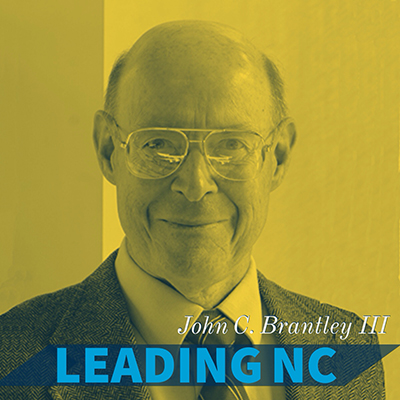
Leading North Carolina is series highlighting the Research Triangle Foundation’s Board of Directors. Bridgette A. Lacy has interviewed each member of the board, and we will be posting her profiles in an effort to give readers an insider’s view of the people helping to guide decisions impacting the future of RTP – and North Carolina. Each board member has a unique background that effects their perspective on how we should redevelop RTP in order to be better positioned for tomorrow’s workers. We are thankful for their time, their wisdom and their willingness to continue working with our team on this journey.
John Brantley is a planner. The retired RDU airport director supervised all aspects of that facility, including management, capital development, operations and airline relations.
He led a major expansion of RDU transforming it from its small World War II roots to become a key gateway for the fast-growing Triangle.
Hired to manage development of a long-range plan at RDU in late 1977, John became the airport director in Oct. 1982. During his 29-year tenure in that role, he led construction of a 10,000-foot runway, American Airlines’ hub facilities, new air cargo and general aviation developments, roadways and parking garages, Terminal 2, and redevelopment of Terminal 1.
“I’m always trying to look down the road and come up with some idea of where we need to go,” he says. “What path do we need to take to get there?”
“John was an outstanding steward of RDU,” says Harvey A. Schmitt, president of the Greater Raleigh Chamber of Commerce. “He fully understood the importance of the airport to the economy of the region. He made sure that RDU not only served the growth of Raleigh and Durham but also was a catalyst to additional growth.”
“One of the things that always impressed me was his ability to combine vision with execution,” says Mr. Schmitt. “The airport of today was built around his promise of quality service in a dynamic industry and region.”
Research Triangle Park and RDU have always had a close synergy. Governor Luther Hodges reportedly said in the late 1950s the first brick would not have been laid at Research Triangle Park had it not been for the Park’s proximity to RDU.
Increased air traffic at RDU was closely related to the success of the Park. The businessmen and women working in and visiting RTP often came through the airport.
The Raleigh native and ’64 N.C. State graduate recalls when the Park was struggling to get its first bona fide industry. The year after he graduated from college, IBM announced it was coming to the Park.
He left the area for eight years to attend graduate school and then work for the Federal Aviation Administration in Atlanta and in airport planning and engineering consulting. He returned home in 1972.
“When I went to RDU in 1977, the airport by and large was not too different from the facility that had been constructed during World War II. Growth had come in some spurts in this area but not what it would later become,” he explains.
At that time, the federal government regulated air transportation, limiting air carrier fares and routes flown. In late 1978, Congress deregulated the air transportation industry, freeing carriers to charge fares and fly routes of their own choosing.
But RDU didn’t quite take off. “One of the biggest problems was lack of access. Raleigh was not on the interstate highway system then,” John explains.
A decade later with the pressure of the U.S. Olympic Festival being held in the Triangle region, I-40 would connect Triangle-area residents to the airport and other North Carolina cities including Wilmington, and to I-85 near Hillsborough.
The airport already was expanding and adding new facilities, which generated more flights and more passengers, cargo and vehicles. As the airport business took off, area universities increased their enrollment and programs. Meanwhile, the Park was attracting large and small technology, research and software companies.
During his tenure at RDU, John explains RTF focused on recruiting new industry to the Park. For many years state officials declared Research Triangle Park the 13th largest community in North Carolina in the daytime. “You didn’t have anybody who lived there,” says John. “They all came to work in the morning and left in the late afternoon. There were no occupants in evening.”
But the Foundation is now shifting its role to take a new look at community expansion. That’s one of the roads John paved during his decades at the RDU. As the architect behind its capital improvements and property management, he brings a lot of development experience to the board.
“The plan for developing the Park Center is something badly needed,” he says. “We need a multi-use Park with residential, commercial, retail and office space. That’s something the Park has never had before.”
He continues, “So this change in direction is an effort to make the Park a true city where people live, work, shop and play…instead of a place to which you commute.”